A week in Tbilisi – and beyond
An interesting country to visit, with a turbulent history and fantastic food, Georgia remains a place of intense geopolitical significance.
I’ve spent the last week in the Georgian capital Tbilisi. While I’m a journalist and economist mainly focussed on the UK and the West, I’ve also worked and travelled extensively across the post-Communist world – so this isn’t my first trip to Georgia.
In this post, I’m going to talk about why Tbilisi – now served by direct flights from London – and Georgia generally are so interesting and enjoyable as places to visit.
In a subsequent post, I’ll discuss the ongoing geopolitical significance of this fascinating country. Located in the Caucasus, Georgia has for centuries served as a transit hub for global trade and energy routes. With its hugely strategic Black Sea coast and long border with Turkey, Georgia has for centuries been a gateway to European and global markets.
Traditionally, it has been Russia and the West – in recent decades both the US and the European Union – that have vied for influence in Georgia. But what really struck me during this, my most recent trip, has been Tbilisi’s intensifying relationship with Beijing – and Georgia’s growing role in China’s era-defining Belt and Road Initiative, amplifying this country’s global importance as an economic and strategic hub.
My second post from Tbilisi – “Georgia on my mind - and China’s too” – will be published shortly. But for now, here’s a post on why Georgia is a great place to visit.
Turbulent and complex - Georgian history is never dull
Tbilisi dates back to the 4th century AD and boasts a diverse architectural landscape – from medieval to neoclassical, pre-revolutionary to Soviet brutalist, reflecting the country’s turbulent history.
You can get a sense of the huge range of different building style from this panning shot of the Tbilisi skyline – which I took on my phone.
Georgia itself is also extremely diverse - not least from a geographic standpoint. The country is quite small – roughly the same size as the Republic of Ireland – but stretches from the Black Sea coast to the west to the rugged Caucasus Mountains, made up of two main ranges running through the north and south of the country. Georgia is bordered by Russia to the north and Azerbaijan, Armenia and Turkey to the east and south.
The politics of the Russia/Georgia border remain complex. While Abkhazia and South Ossetia have both declared independence from Tbilisi, most countries consider them still to be part of Georgia. Since Russia’s war with Georgia in 2008, though, Moscow has backed separatist regimes in Abkhazia and South Ossetia, insisting they are sovereign.
The status of Ajaria - sometimes spelt Adjara – which borders Turkey, is much less controversial. It is universally regarded as an autonomous republic within Georgia, unlike the breakaway regions on the northern border.
I’m in Tbilisi to visit my eldest daughter Ailis Halligan, who is almost 25 and making her way as a journalist, linguist and specialist on the Former Soviet Union. She previously lived in both Russia and Estonia – and has also visited Central Asia. Now based in Georgia, Ailis is learning about this deeply historic country located at the crossroads of Europe and Asia.
During our week together, Ailis and I spent most of our time in the Georgian capital, which boasts a myriad of interesting attractions. Probably the most famous is Tbilisi’s Narikala Fortress, built in the 4th century AD, when the city was founded. Its name means “little fortress” in Turkic – and Narikala can be reached either by climbing the stairs from Tbilisi’s charming Old Town or by taking a cable car from the more contemporary Rike Park.
Rezo Gabriadze Puppet Theatre is also a must-see – built in the early 1980s and named after a celebrated Georgian director and playwright. It is housed in a very distinctive traditional wooden building, including a famous clock tower – and twice daily you can watch “Circle of Life”, Gabriadze’s iconic puppet vignette, along with other longer performances.
The Bridge of Peace deserves a mention – a striking 150-metre pedestrian path, built in 2010, across Tbilisi’s river Kura. Designed by Italian Michele De Lucchi, it links the Old Town with Rike Park – and at night is lit by thousands of LED lamps that, believe it or not, flash messages in morse code!
Tbilisi also has a buzzing live music scene, with multiple gig listings every night. Ailis and I went to see an up-and-coming Tbilisi-based Russian band called Миролюбивое море - or Peaceful Sea – at a fantastic local venue called Mechanica Club. We also went to Fabrika – a Soviet-era sewing factory that has been transformed into a hub of creative industries and is a hotspot for cool cafes, restaurants and bars.
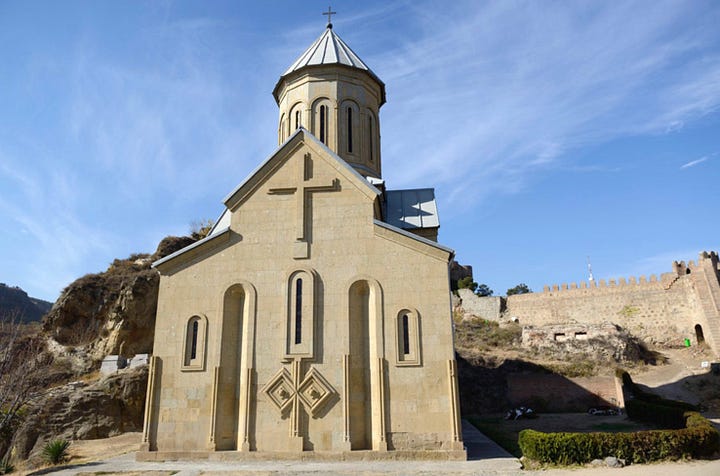
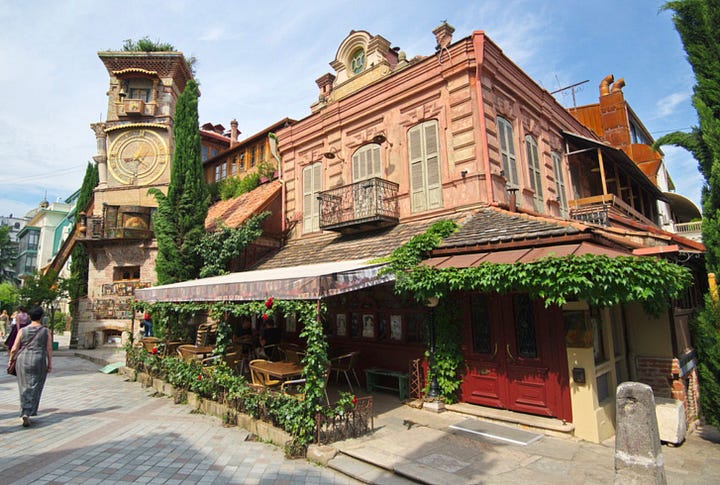


Mtshketa and Sighnaghi
There are many worthwhile day trips within easy reach of Tbilisi and the first one we did was to Mtskheta – the capital of the early Georgian Kingdom of Iberia from the 3rd century BC to the 5th century AD. A Unesco World Heritage Site, Mtshketa is where Georgia accepted Christianity sometime around the year 320 and is home to the celebrated Jvari Monastery, built in the 6th century AD.
Mtshketa is also where the Kura (sometimes known as Mtkvari) meets one of its main tributaries, the Aragvi - which originates in the Caucasus mountains. From the Jvari Monastery, which is up on a hill, you can see the distinct colours where the rivers meet – due to differences in sediment, water composition, temperature and flow dynamics.
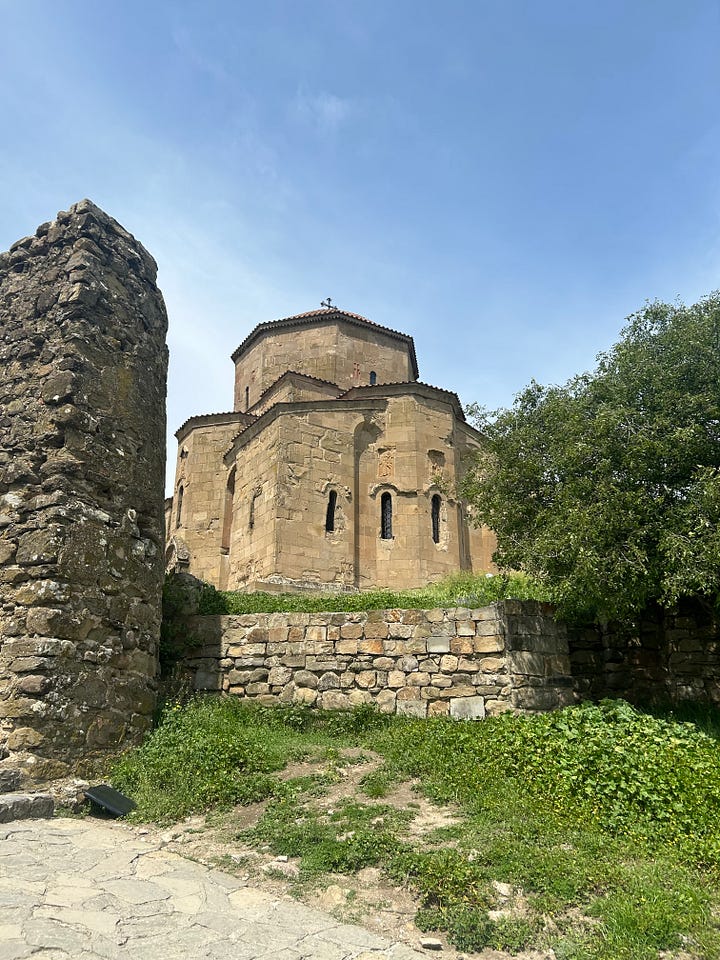
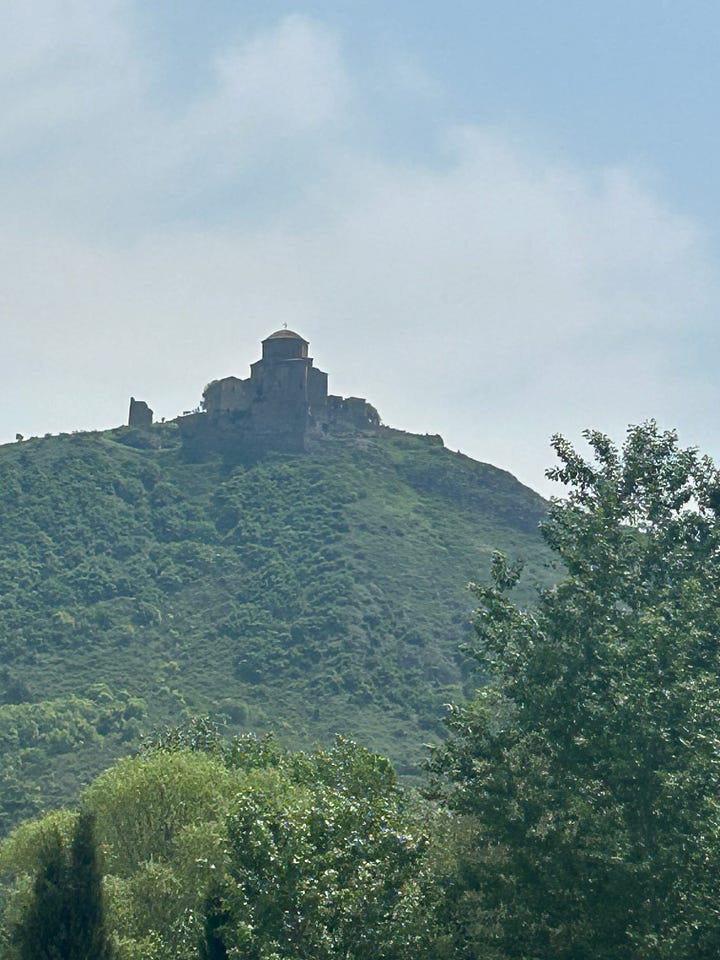


Ailis and I also did a separate trip to Sighnaghi - in the eastern part of Kakheti, Georgia’s main wine-making region, close to the border with Armenia and Azerbaijan.
This is one of Georgia’s most attractive small towns, combining charming cobblestone streets with significant historic and cultural heritage sites – which has led to the development of high quality family-run hotels and fine-dining. We visited the revamped 9th century Bodbe Monastery, set in beautiful, manicured gardens and built on the burial site of St. Nino – who converted Georgia to Christianity at Mtshketa.
Sighnaghi has an impressive City Wall, originally around three miles long with almost thirty towers – built during the 18th century to deter marauding warriors and conquerors and from neighbouring powers and tribes. These included Lezgin groups from the Caucasus, particularly from what is now the Russian republic of Dagestan, but also Persians and Ottomans too.
From the wall, the views overlooking the Alazani Valley are spectacular - with the shadow of the Greater Caucasus in the distance adding an extra level of drama to the scenery. Known as the “City of Love”, Sighnaghi is also a popular wedding venue - with a registry office that operates around the clock.
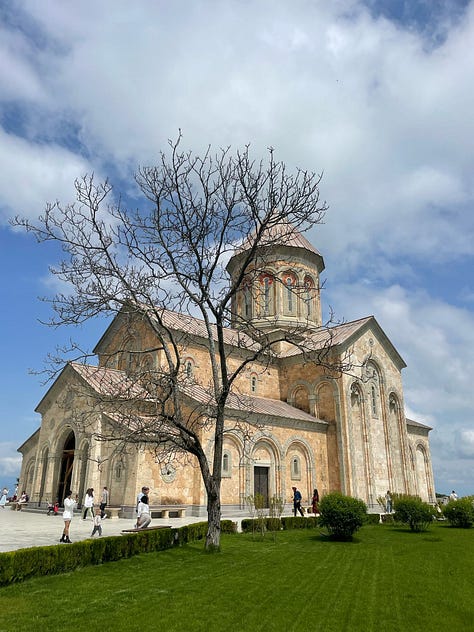
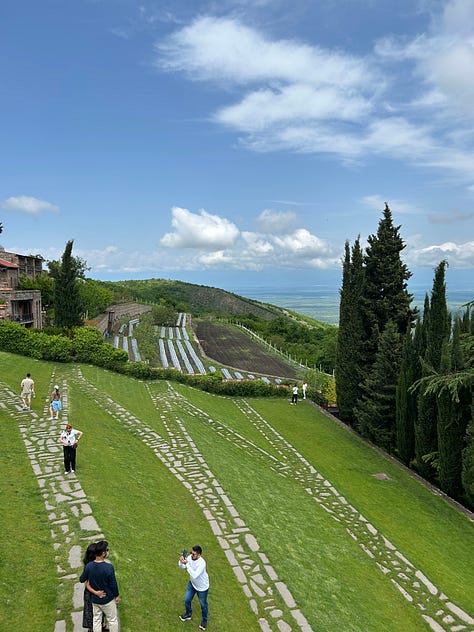
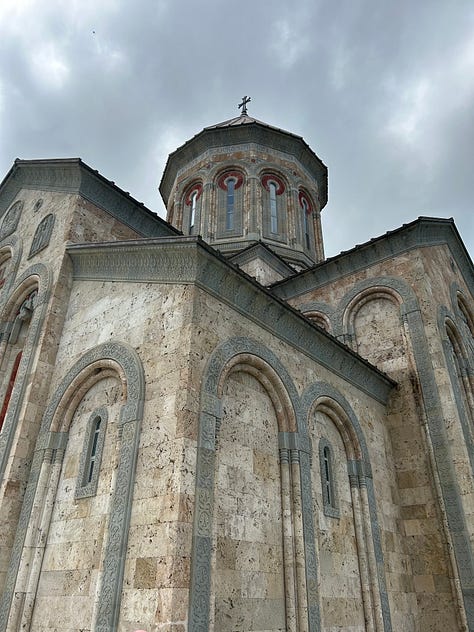
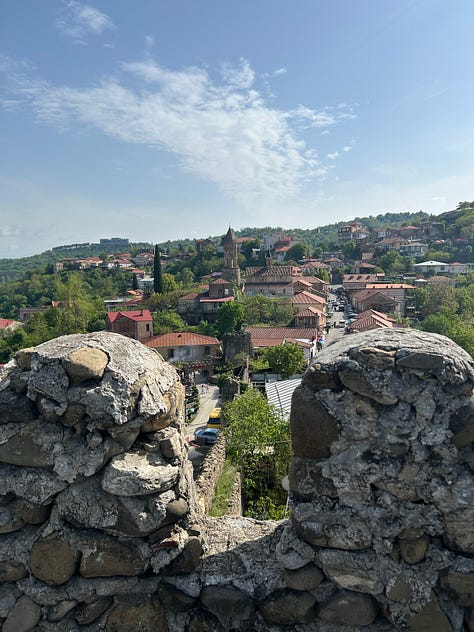
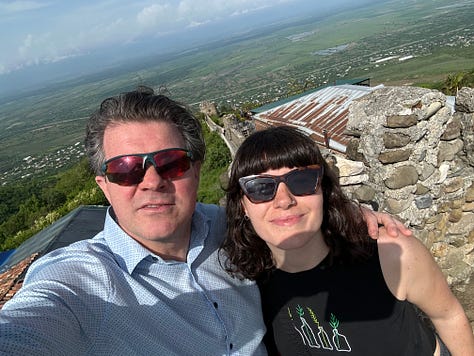
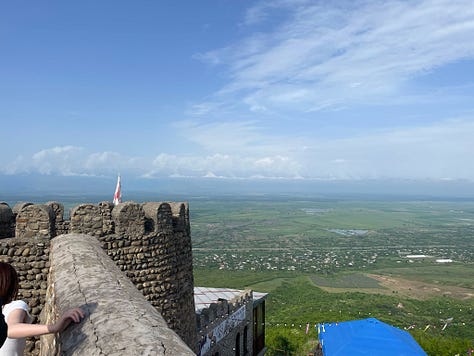
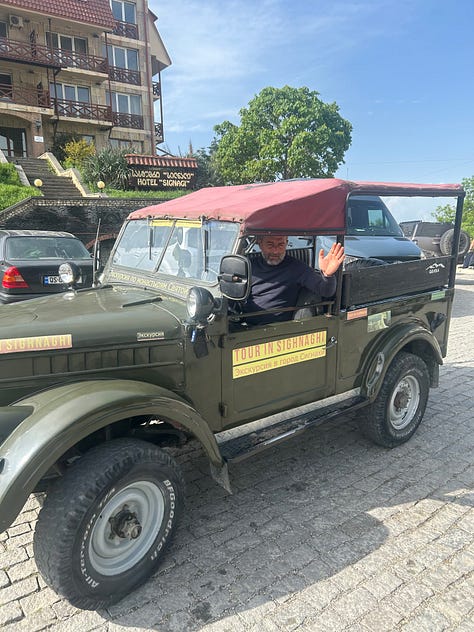
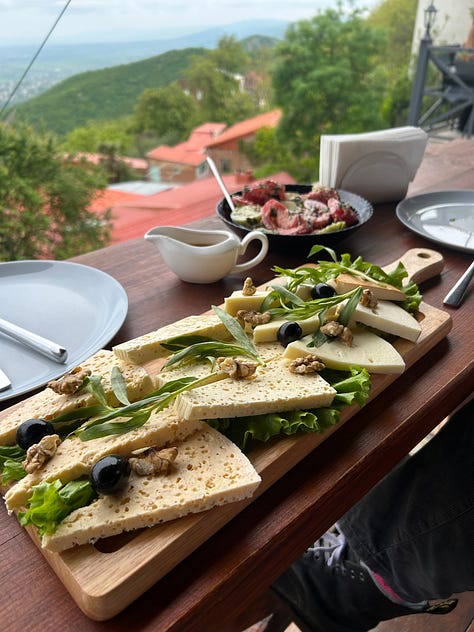
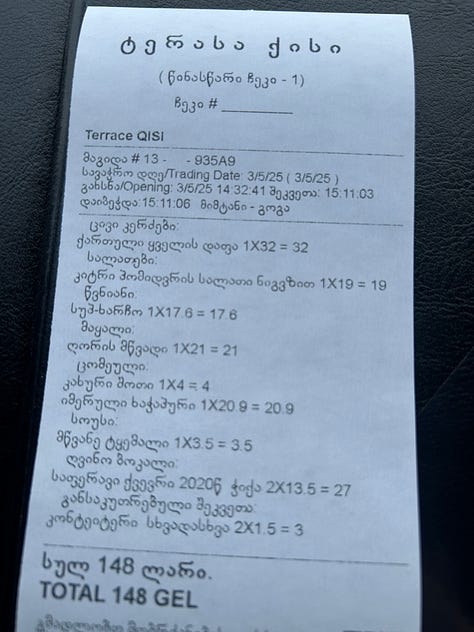
Georgia: a culinary coalescence of cultures
No travel piece on Georgia, even a relatively short one like this, can avoid mentioning the country’s vibrant and flavourful cuisine – which, unsurprisingly, is a kind of European-Asian fusion. Known for bold, hearty dishes that balance savoury, tangy, and subtly sweet flavours, Georgian food uses a myriad of fresh herbs, spices, and other distinctive local ingredients – including walnuts, pomegranates, and tarragon.
Staples of any Georgian dining table include khinkali (juicy soup dumplings filled with spiced meat or mushrooms, eaten with a specific technique to savour the broth) and satsivi (chicken or turkey in walnut sauce). Pkhali are colourful vegetable pastes (made from beetroots, spinach or aubergine) mixed with walnuts and herbs while popular stews include chakhokhbili (chicken in tomato and herb sauce) and ajapsandali (like a super-charged ratatouille).
Pickled vegetables such as jonjoli add tanginess, combining with marinated pork, beef or lamb mtsvadi (shish kebabs) grilled on open fires. Badrijani Nigvzit are aubergine rolls stuffed with walnut paste, garnished with pomegranate seeds while lobio is a spiced kidney bean thick soup, often served with mchadi bread.
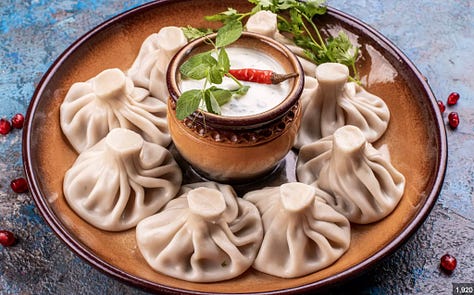


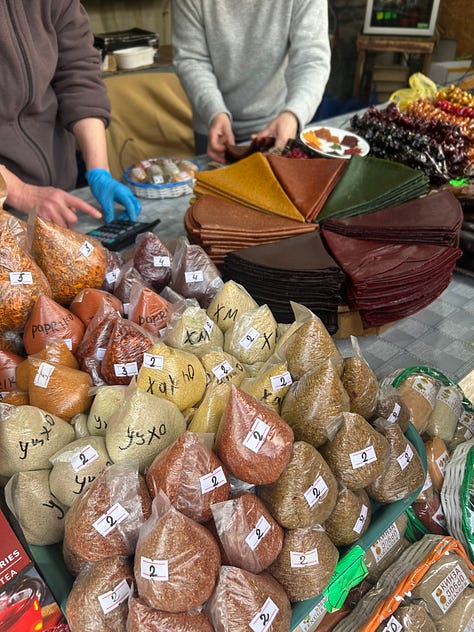
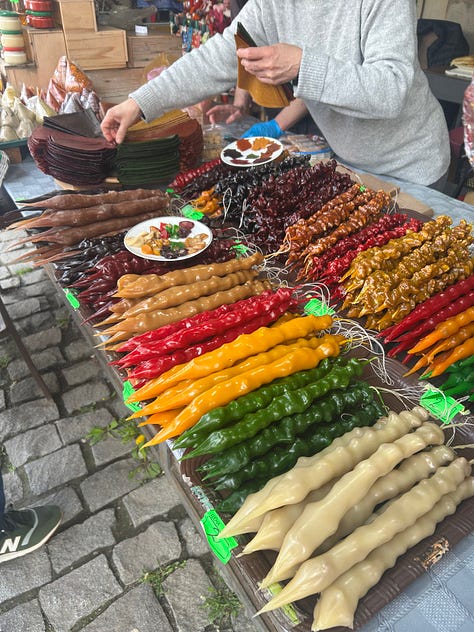
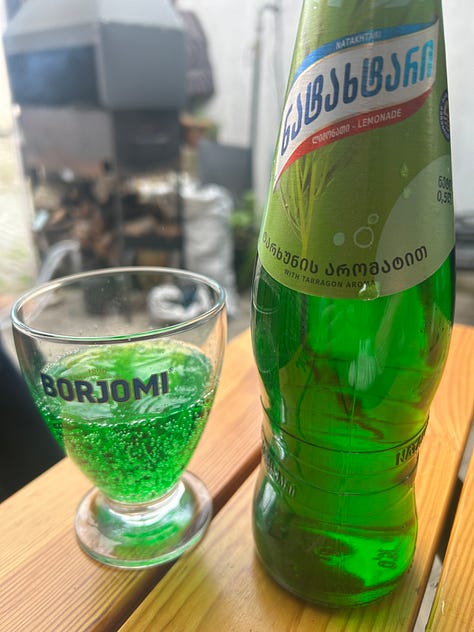
The show-stopper of many Georgian meals is khachapuri – ridiculously delicious cheese-stuffed bread, with regional variations including Imeretian (round) and Adjarian (topped with an egg). Churchkhela is Georgia’s traditional dessert of walnuts strung and dipped in thickened grape juice, like a chewy, natural candy.
When it comes to wine, the choice is endless. Georgia produces unique wines using qvevri (large red clay vessels buried in the ground) for fermentation, a process which dates back thousands of years and helps maintain a stable temperature during the winemaking process. The best local wines use indigenous grape varieties including Saperavi and Rkatsiteli, producing a range of styles, from bold reds (some of which are served cold) to crisp whites and distinctive amber (orange) varieties.
Tarkhuna, meanwhile, is a tarragon-flavoured soda, bright green and refreshing – a famously Georgian drink which is ubiquitous and much-loved across the entire Former Soviet Union.
Overall, Georgian food is nutritious, healthy and extremely tasty – a highlight of any visit to this country.
I hope you enjoyed this post - and thanks for reading. Please let me know in the comments if you have visited Georgia, or if I’ve encouraged you to do so some time soon.
Again, while I’m best known for my weekly “Economics Agenda” column in the Telegraph newspaper, which tends to focus on UK-related issues, I’m also intensely interested in international affairs – most specifically the Former Soviet Union, where I began my journalist career in the early 1990s. That’s why, when I launched When the Facts Change six weeks ago, I said this Substack would “examine the economics and politics of the UK and the Western world in the context of the fast-emerging new world order”.
Indeed, the first interview piece I recently posted on When the Facts Change was an exclusive interview with Mike Calvey – a US-born businessman who moved to Moscow in the early 1990s and ended up living there for almost thirty years. Having built a stellar asset management company that raised billions of dollars from blue-chip Western investors for companies across Russia and the Former Soviet Union, Mike ended up in jail on charges trumped-up by a business rival.
Now fully exonerated, Mike’s new book “Odyssey Moscow: One American’s journey from Russia optimist to prisoner of the state” – dedicated to the six Russians with whom he shared a cell in Moscow’s notorious Mattrosskaya Tishina prison, famous for holding Soviet-era coup-plotters – is a fabulous read. And he tells his story in a fascinating and, if I may say so, often quite amusing hour-long interview with me here on When The Facts Change.
My second post from Tbilisi – Georgia on my mind - and China’s too – will focus on geopolitics, specifically the fast-growing importance of the so-called Middle Corridor from China to Western Europe across Eurasia, the Caspian region and the Black Sea.
That will be published shortly - and I hope you take a look.


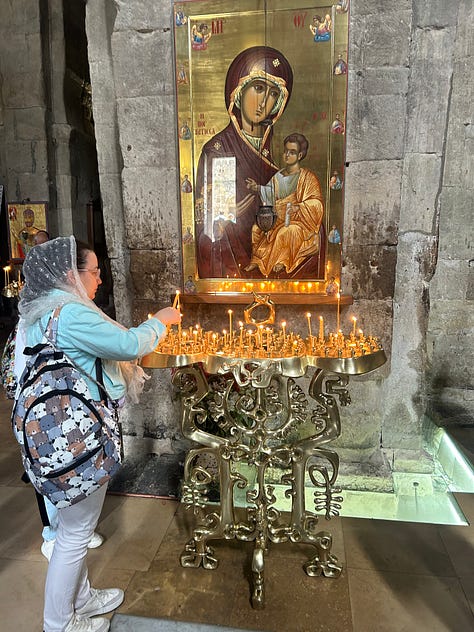
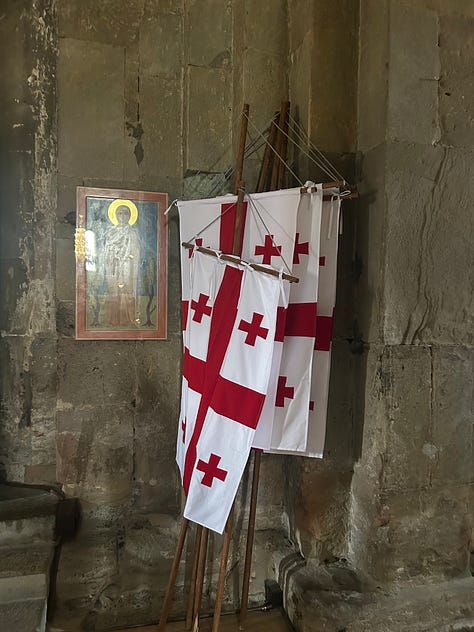

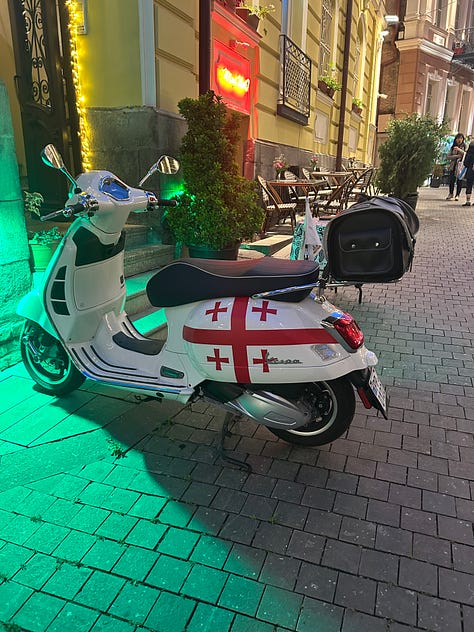

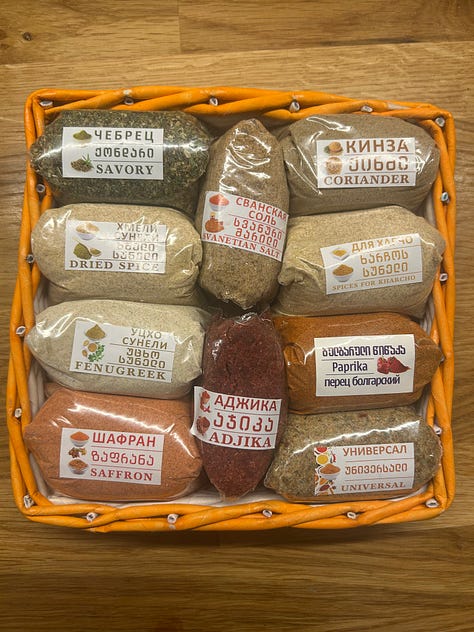
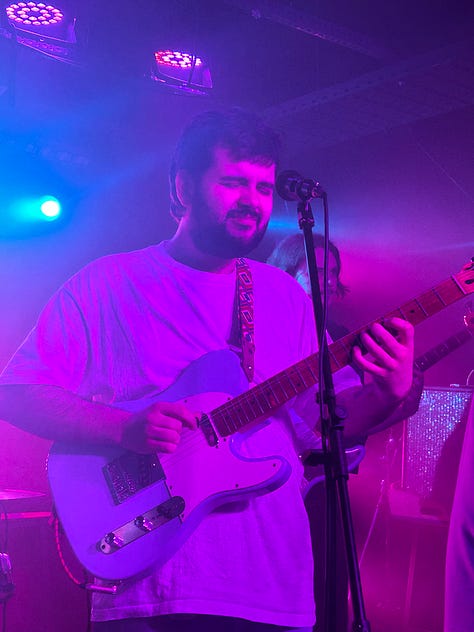





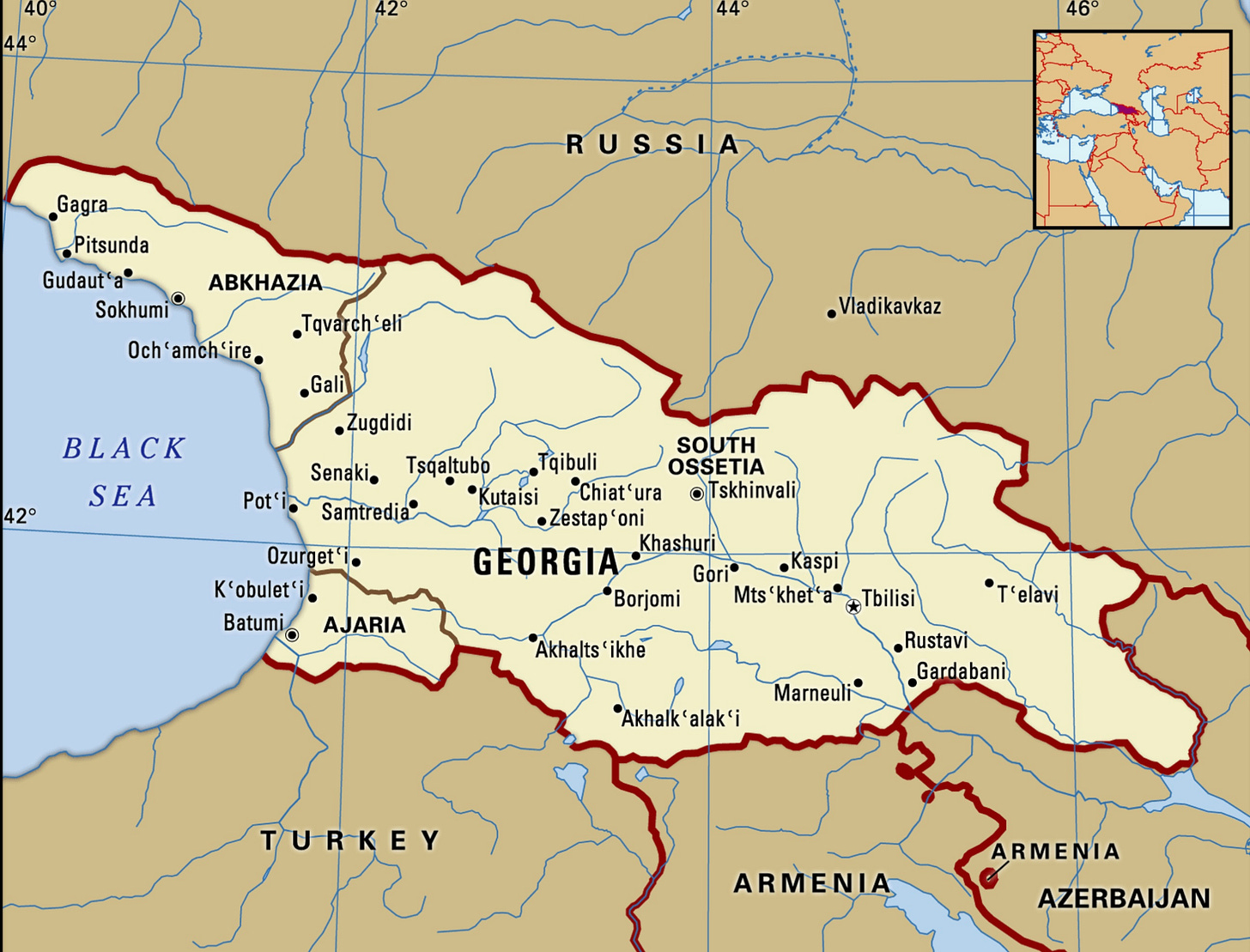
What an interesting article, I want to visit now! Looks like you had a great time, a nice change from your usual topics thanks for sharing
The photography was just as good as the piece. Thank you.